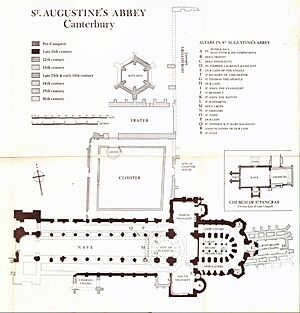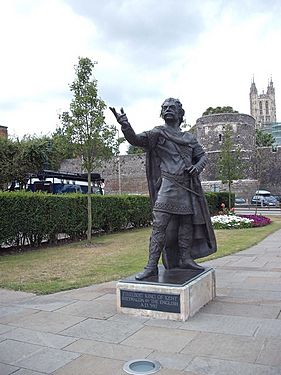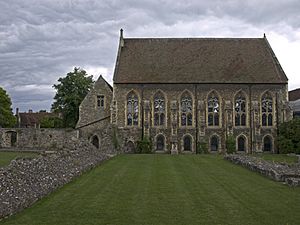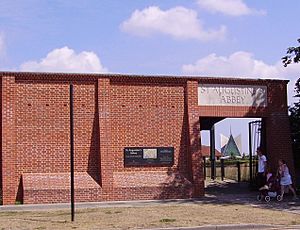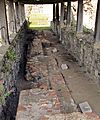St Augustine's Abbey facts for kids
| UNESCO World Heritage Site | |
|---|---|

Abbot Fyndon's Great Gate, with Lady Wootton's Green in the foreground, is a private entrance into the King’s School. The public entrance to the abbey ruins is on Longport.
|
|
| Location | Canterbury, Kent, United Kingdom |
| Part of | Canterbury Cathedral, St Augustine's Abbey, and St Martin's Church |
| Inscription | 1988 (12th Session) |
| Area | 8.42 ha (20.8 acres) |
St Augustine's Abbey was a famous Benedictine monastery in Canterbury, Kent, England. It was first called the Monastery of Ss Peter and Paul. It was founded in 598 by Augustine of Canterbury, a saint who helped bring Christianity to England. The abbey worked as a monastery until 1538. This was when King Henry VIII closed down many monasteries during the English Reformation.
After it closed, parts of the abbey were taken apart until 1848. Since then, some of the land has been used for schools. The old abbey ruins are now protected because they are very important historically.
Contents
The Abbey's Early Days
In 597, Augustine came to England. He was sent by Pope Gregory I to teach Christianity to the Anglo-Saxons. The king of Kent at that time was King Æthelberht. He worshipped pagan gods, but his wife, Queen Bertha, was a Christian.
King Æthelberht gave Augustine his pagan temple and the land around it. He wanted Augustine to build a church and monastery there. The king also said the church should be "splendid" and dedicated to Saints Peter and Paul. One main reason for building it was to give Augustine and his monks a home. Both the king and Augustine also planned for the abbey to be a burial place for important people. This included abbots, archbishops, and the kings of Kent.
A historian named William Thorne wrote that the abbey was founded in 598. The first monastery buildings were probably made of wood. This meant they could be built quickly. However, a stone church, like the ones Augustine knew in Rome, took much longer. The church was finished and officially opened in 613. Around 624, King Eadbald, Æthelberht's son, built a second church nearby. This one was for Saint Mary and also buried Kentish royalty. After Augustine died, the abbey became known as St Augustine's.
For 200 years, St Augustine's was the most important religious place in Kent. It was like a "missionary school" where people learned about classical subjects and English history. The abbey also had a huge library with many religious and non-religious books. It even had a scriptorium, which was a room where monks copied and created new books by hand.
Changes by Archbishop Dunstan
Dunstan was the Archbishop of Canterbury from 959 to 988. He helped change the abbey to follow the rules of the Benedictine monks. The buildings were made bigger, and the church was rebuilt. Dunstan also changed the abbey's name in 978. He added Saint Augustine to the original dedication of Saints Peter and Paul. From then on, it was called St Augustine's Abbey.
When the Danes Visited
The Danes were invaders, but they did not harm St Augustine's. In 1027, King Cnut gave all the lands of another monastery, Minster-in-Thanet, to St Augustine's. These lands included the preserved body of Saint Mildred. Many people across Europe believed in the healing power of this relic. This brought many pilgrims to St Augustine's, and their gifts made the abbey very rich.
After the Norman Conquest
After the Norman Conquest in 1066, William the Conqueror took over many lands. But he respected church property. At St Augustine's Abbey, the old Anglo-Saxon buildings were completely rebuilt. They were made into a typical Norman Benedictine monastery. By 1100, all the original buildings were replaced with new Romanesque ones. More rebuilding happened after a big fire in 1168. This fire destroyed many old records, so we don't know much about the time before it.
From about 1250, the abbey became very wealthy. Many new buildings were constructed. This was a time of "worldly magnificence," with lots of money spent on new buildings, royal visits, and huge banquets. The Pope also asked the abbey for a lot of money. The abbey got into a lot of debt, but generous people helped them out.
The cloister (a covered walkway), the frater (dining hall), and the kitchen were all rebuilt. A new home for the abbot and a large hall were added. In the early 1300s, land was bought for a cellarer's range (living and working areas for the person in charge of food and drink), a brewery, a bakery, and a new walled vineyard. A Lady chapel was also built to the east of the church.
Fyndon’s Great Gate
The main gatehouse of the abbey was rebuilt between 1301 and 1309 by Abbot Fyndon. It is now known as the Fyndon Gate or the Great Gate. The room above the entrance was a special bedroom for important guests. In 1625, Charles I of England and Queen Henrietta Maria slept there after their wedding. In 1660, Charles II and his brothers also stayed in the gatehouse on their way to London.
Fyndon's Gate was badly damaged by German bombs during World War II. It had to be rebuilt. The gate faces a small square called Lady Wootton's Green. This name comes from the widow of Edward, Lord Wootton, who lived in the palace until 1658. Statues of King Æthelberht and Queen Bertha stand on the green today.
St Anne's Chapel
In the 1360s, Juliana Leybourne paid for a chapel to be built next to the abbey. It was called the "Countess's Chapel" or "St Anne's Chapel." This was a small square chapel with its own supports. Important abbots were buried there, and Juliana Leybourne herself was also buried in the chapel. She gave land to the abbey and asked for daily prayers to be said for her after she died.
From Closing Down to Today
The early 1500s were a difficult time for monasteries. Even though St Augustine's Abbey owned a lot of land (nearly 20,000 acres), it was facing financial problems. The Pope asked for so much money that the abbey was almost bankrupt.
However, the English Reformation happened first. This was a big change where the King, not the Pope, became the head of the church in England. Parliament also made laws that gave more power to ordinary people rather than church leaders. This led to a "great transfer" of power and wealth from the church to the government.
As part of this change, King Henry VIII was given the power to close monasteries and take their property. The reason given was that the monasteries were not using their wealth for religious purposes anymore.
On July 30, 1538, the King's officials arrived to close St Augustine's Abbey. The last abbot and monks agreed and left. The abbey, its buildings, lands, and all its possessions became the property of the King. This ended over 940 years of monastic life there.
Taking the Abbey Apart
For the rest of King Henry VIII's rule, St Augustine's Abbey belonged to the Crown. Some buildings were turned into a royal home. But in other parts, the abbey was taken apart, and materials were sold starting in 1541. Some stones were used for forts in Calais, France, but most were sold locally. The abbey's library, which had 2,000 handwritten books, was destroyed, and its treasures were stolen.
The royal home was sometimes used by the monarch, even by Queen Elizabeth I. In 1564, she rented the palace to Lord Cobham. In 1573, she visited Canterbury and stayed at her palace at St Augustine's.
After Lord Cobham was accused of treason in 1603, King James I gave the home to Robert Cecil. After Cecil died in 1612, King James rented the palace to Edward, Lord Wootton. Lord Wootton hired a famous gardener, John Tradescant the Elder, to design beautiful gardens. In 1618, King James allowed people to search for hidden treasures in old abbeys. As a result, the abbey and its surrounding land were dug up.
Lord Wootton died in 1626, but Lady Wootton lived in the palace until 1658. The open area in front of the gate is still called Lady Wootton's Green.
Sir Edward Hales took over the property after Lady Wootton died. He and his son, Sir Edward Hales, did not protect the abbey. Instead, they took down buildings and used the stones to build a new house at Hales Place.
From then until 1844, the destruction continued. The church, cloister, kitchen, and dining hall were all ruined. Other parts of the site were also damaged. From 1770 to 1844, a brewery operated within the abbey grounds. In 1804, part of the site was divided and sold. The Great Court was used for games like bowling. Ethelbert's Tower, the last Norman tower, was pulled down in 1822. A historian named Robert Ewell wrote that in the early 1800s, the abbey was at its "lowest point of degradation."
Bringing the Abbey Back to Life
The sad state of the abbey was noticed. In 1844, a rich young landowner and politician named Alexander Beresford Hope visited the ruins. He found them terrible and bought them. Inspired by Reverend Edward Coleridge, Hope and other donors gave money to fix and build new parts. They wanted to create a college to train young men as missionaries for British colonies. The college had two goals: to educate missionaries and to dig up and protect the abbey's remains.
St Augustine's Missionary College existed until 1947. However, on May 31, 1942, its buildings were badly damaged by a German air raid during World War II. Because of this, the college stopped operating.
From 1952 to 1967, the Missionary College buildings were used as The Central College of the Anglican Communion. From 1969 to 1976, the theological department of King's College London used the college.
Since 1976, the college buildings, along with some new ones, have been used by The King's School, Canterbury. They are used for student boarding homes and the school library. The King's School bought this part of the St Augustine's Abbey site in 1994.
In 1940, the abbey ruins were taken care of by the British government. They are now managed by English Heritage. St Augustine's Abbey is part of a World Heritage Site with Canterbury Cathedral and St Martin's Church. This means it's recognized as a very important place for everyone in the world.
What Ruins You Can See Today
-
A view of Canterbury Cathedral from the abbey ruins
-
The gravesite of Augustine of Canterbury
Important People Buried Here
Many important people were buried at St Augustine's Abbey, including:
- Æthelberht of Kent, King of Kent
- Eadbald of Kent, King of Kent
- Theodore of Tarsus, an Archbishop of Canterbury
- Emma of Austrasia, wife of King Eadbald
- Justus, an early Archbishop of Canterbury
- Juliana Leybourne, a wealthy landowner and supporter of the abbey
- Mellitus, an early Archbishop of Canterbury
See also
 In Spanish: Abadía de San Agustín para niños
In Spanish: Abadía de San Agustín para niños


